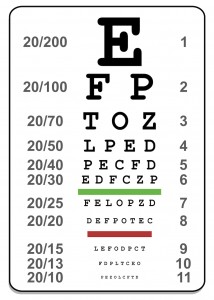Vision Testing in Children
Approximately 80 percent of learning is acquired visually
Recommendations for Vision Screening in Children
The goal of vision testing is to identify and treat vision problems as early as possible. Up until now, we have relied on the doctor’s exam and the parents’ observations to diagnose an issue. Pediatricians and parents are sometimes able to recognize a vision problem, but often we don’t discover it until the preschool/kindergarten well visit when children are capable of being tested by the traditional eye chart.
Over the past decade, we have experienced a huge advance in vision testing for young children. We are now able to identify and treat significant issues in children as young as 12 months of age that would otherwise not be detected until at least age 4. The newer technologies used to diagnose vision problems in young children are expensive and may not be covered by your insurance. So that these tests are available to everyone, we offer them for a reasonable cash price regardless of insurance coverage.
Forest Lane Pediatrics has recommended a systematic schedule to have these screenings done. Like any screening exam, these tests are intended to be sensitive enough to detect any problem, but will sometimes result in a “false positive”. In other words, if your child’s test is abnormal, that does not mean he or she is blind or needs glasses or other treatment. We will refer you to an ophthalmologist (an eye doctor) who will examine your child and provide a more complete diagnosis. Whether or not you choose to utilize these optional vision tests, your doctor will always conduct a thorough examination of your child’s eyes at each well visit.
Vision Tests Available for Children age 12 Months to Teenagers

Occular Photoscreener – 12 months to 4 years old
Fast, child-friendly, camera-like vision screening test for kids!
Spot Vision® is a high-end optics and infrared light scanning device combined with sophisticated software, algorithms, and infrared imaging technology.
This machine is designed to assess for refractive errors that cause blurred vision. The test is quick and only requires the child to focus at the machine for a few seconds. Designed to work as easily with toddlers as with teenagers, the test presents immediate screening results. The sophisticated technology provides reliable analysis that enables informed decision making about the need for follow-up diagnosis if the following are detected:
- Pupil size deviations (anisocoria)
- Eye misalignment (strabismus)
- Near-sightedness (myopia)
- Far-sightedness (hyperopia)
- Unequal refractive power (anisometropia)
- Blurred vision, eye structure problem (astigmatism)
Snellen Eye Chart – 4 years and older
This is the traditional method to assess visual acuity. We use either letters or shapes to find out how well your child can see. This is an “old-fashioned test”, but it is still effective at diagnosing vision problems in older children. We start performing this test around 4-5 years old. If a child has trouble communicating the images of the eye chart, then Spot Vision testing is recommended.
Recommended Vision Screening Schedule
If your insurance covers vision screening for young children, we will screen as per their recommendations. If your insurance does not cover vision screening for young children, we recommend the following schedule:
- 12 months to 4 years: Spot Vision (annually)
- 4 years and older: Snellen eye chart and Spot Vision if necessary
Please talk with your pediatrician if you have more questions about these tests.






